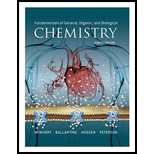
(a)
Interpretation:
Concept Introduction:
Enthalpy
The value of heat formed in a reaction
If the value obtained for
(b)
Interpretation:
Whether the photosynthesis reaction is endothermic or exothermic has to be found.
Concept Introduction:
Enthalpy
The value of heat formed in a reaction
If the value obtained for
Want to see the full answer?
Check out a sample textbook solution
Chapter 7 Solutions
Fundamentals of General, Organic, and Biological Chemistry - With Access
- Suppose a 500.mL flask is filled with 1.7mol of H2 and 0.20mol of HCl. The following reaction becomes possible: H2(g)+Cl2(g)-->2HCl(g) The equilibrium constant K for this reaction is 4.78 at the temperature of the flask. Calculate the equilibrium molarity of Cl2. Round your answer to two decimal places.arrow_forwardA reaction at 23°C has ∆G = 1 kJ mol–¹. Why might this reaction become spontaneous at 37°C?arrow_forwardPotassium nitrate is widely used in industries. The reaction for the industrial production of KNO3 is summarized in the equation below; 4KCl + 4 HNO3 + O2 → 4 KNO3 + 2 Cl2 + 2 H2O Which of the following statements below is correct about the production of KNO3? a. A redox reaction; KCl is a reducing agent and O2 is an oxidizing agent b. A redox reaction; HNO3 is a reducing agent and Cl is an oxidizing agent c. Not a redox reaction d. A redox reaction; KCl is a reducing agent and KNO3 is an oxidizing agent e. A redox reaction; HNO3 is a reducing agent and KNO3 is an oxidizing agentarrow_forward
- For the reaction A → B at 298 K, the change in enthalpy is −7 kJ · mol−1and the change in entropy is −25 J · K−1 · mol−1. Is the reaction spontaneous? If not, should the temperature be increased or decreased to make the reaction spontaneous?arrow_forwardThe phosphoryl group transfer potentials for glucose-1-phosphate and glucose-6-phosphate are 20.9 kJ/mol and 13.8 kJ/mol, respectively. (a) What is the equilibrium constant for the reaction shown below at 25 °C? (b) If a mixture was prepared containing 1 m glucose-6-phosphate and 1 x 10-3 M glucose-1-phosphate, what would be the thermodynamically favored direction for the reaction?arrow_forwardYou have an initial solution in which you added quantities of “A” and “B” such that there is 4.5 M “A” and 2.5 M “B” and no complex (“AB”) at time 0. After equilibrium, you are able to isolate and quantitate the “AB” complex, and find its concentration is 1.5 M. Given that RT is 0.59 kcal/mol, what is the delta Go’ for the association reaction?arrow_forward
- This is a plot under standard conditions of free energy corresponding to a chemical reaction of A+B to C+D. What will happen if only C+D are present under standard temperature and pressure? Please explain why.arrow_forwardCalculate ΔG°′ for the reaction A + B ⇌ C + D at 25°C when the equilibrium concentrations are [A] = 10 μM, [B] = 15 μM, [C] = 3 μM, and [D] = 5 μM. Is the reaction exergonic or endergonic under standard conditions?arrow_forwardConsider the following process: NaCl(s) water−→−−water→ Na+(aq) + Cl-(aq); ΔH = +4.2 kJ/mol Under what conditions (temperature) would you expect this process to be spontaneous? Select a relatively high temperature and a relatively low temperature, calculate (estimate) the relative values of ΔG to support your conclusion. The entropy increases in this process Please insert an image of your workarrow_forward
- The conversion of glucose-1-phosphate to glucose-6-phosphate by the enzyme phosphoglucomutase has a △G°' of -7.6 kJ/mol. Calculate the equilibrium constant for this reaction at 298 K and a pH of 7. (R = 8.315 J/K-mol) A. 0.003 B. 0.047 C. 1.00 D. 21arrow_forwardCalculate the standard free energy change (ΔG°′) for the following reaction: ½ O2 + FADH2 → H2O + FADarrow_forwardIf you measured the rate of reaction at 20°C to be 1.11 x 10-5 M/s when using 0.080 M I1- and 0.040 M S2O82-. Approximately how long will the reaction take if you were to increase the temperature to 30 °C?arrow_forward
 BiochemistryBiochemistryISBN:9781319114671Author:Lubert Stryer, Jeremy M. Berg, John L. Tymoczko, Gregory J. Gatto Jr.Publisher:W. H. Freeman
BiochemistryBiochemistryISBN:9781319114671Author:Lubert Stryer, Jeremy M. Berg, John L. Tymoczko, Gregory J. Gatto Jr.Publisher:W. H. Freeman Lehninger Principles of BiochemistryBiochemistryISBN:9781464126116Author:David L. Nelson, Michael M. CoxPublisher:W. H. Freeman
Lehninger Principles of BiochemistryBiochemistryISBN:9781464126116Author:David L. Nelson, Michael M. CoxPublisher:W. H. Freeman Fundamentals of Biochemistry: Life at the Molecul...BiochemistryISBN:9781118918401Author:Donald Voet, Judith G. Voet, Charlotte W. PrattPublisher:WILEY
Fundamentals of Biochemistry: Life at the Molecul...BiochemistryISBN:9781118918401Author:Donald Voet, Judith G. Voet, Charlotte W. PrattPublisher:WILEY BiochemistryBiochemistryISBN:9781305961135Author:Mary K. Campbell, Shawn O. Farrell, Owen M. McDougalPublisher:Cengage Learning
BiochemistryBiochemistryISBN:9781305961135Author:Mary K. Campbell, Shawn O. Farrell, Owen M. McDougalPublisher:Cengage Learning BiochemistryBiochemistryISBN:9781305577206Author:Reginald H. Garrett, Charles M. GrishamPublisher:Cengage Learning
BiochemistryBiochemistryISBN:9781305577206Author:Reginald H. Garrett, Charles M. GrishamPublisher:Cengage Learning Fundamentals of General, Organic, and Biological ...BiochemistryISBN:9780134015187Author:John E. McMurry, David S. Ballantine, Carl A. Hoeger, Virginia E. PetersonPublisher:PEARSON
Fundamentals of General, Organic, and Biological ...BiochemistryISBN:9780134015187Author:John E. McMurry, David S. Ballantine, Carl A. Hoeger, Virginia E. PetersonPublisher:PEARSON





